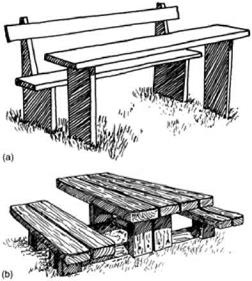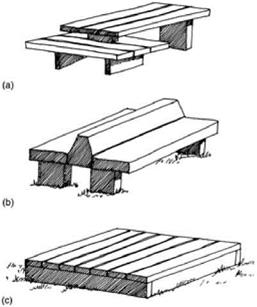Metal, usually steel, is used as a frame and occasionally for the table and bench tops. Painted steel looks urban, while plastic-coated or enamel-coated steel is similarly too highly finished. Galvanized steel can work in the more urban settings and is vandal resistant. With simple form, and by using wooden table and bench tops, it can be acceptable.
Plastic
Plastic is being used as a wood substitute in some places. This sounds strange, but a material made from recycled plastic looks like some timbers, is hard-wearing, can be worked like wood, and is durable. It might be a substitute for durable tropical hardwoods or chemically preserved softwood on some sites where applying principles of sustainability is important.
Wood
Wood is the all-round favourite, but it can be used well or badly depending on the site and its construction. The usual problems include the use of round timber to give a ‘rustic’ effect. This tends to look very suburban if the scale is not large enough or the timber cylindrical. The bench and table top must be level, and can be made from half-round sections of logs properly sawn and finished. Sawn wood is better but needs large sizes to be robust, durable, heavy and to blend with the scale of the landscape. Simply cut sections can be bolted together to form strong structures without the need for diagonal bracing, which gets in the way of people’s knees. All surfaces should be planed smooth to prevent splinters. Narrow gaps between planks on the table and bench tops should be left to allow drainage of rainwater. Domestic designs that resemble schoolroom desks should be avoided.
|
This is a better effort at a table from Norway; it is made from round and half-round timber, peeled and without taper, although it remains quite clumsy and looks potentially unstable. |
Good durable timber can be left untreated to weather, and will last for years if water is drained off and air circulates around the wood. Cedar, oak heartwood, larch heartwood and chestnut can be suitable timbers for this, and to a lesser extent Douglas fir and Scots pine. Others need preservative before being left to weather. Stains can also be used to tie the furniture into the landscape or to other artefacts.
|
(a) This table and bench look too much like domestic or schoolroom furniture to be successful outdoors. (b) This unit is of solid and robust construction. It is movable, but its dimensions and weight |
are likely to reduce the risk of its being stolen.
Scottish Natural Heritage.
Paints can be a problem if they crack or split with the swelling or shrinkage of timber. ‘Corporate’ or house colours should be used sparingly, as they can frequently look out of place for the local setting. Varnish and paint finishes seal the surface so that in wet weather water tends to stand in globules on the surface, taking longer to dry than on stains, which allow water to run off or soak in a little.
Although the designs of many tables and benches in the outdoors originate from the home, other constructions can be considered. If sitting on the ground in traditional picnic fashion is not ideal because of damp grass or an uncomfortable surface, low pallets can be provided. Wide benches or structures that can double as benches or tables might also allow a more free-and-easy way of having a picnic. All these can be experimented with. Some might be more flexible for parties of different sizes or ages.
|
These designs try to vary the traditional picnic table theme: (a) An interlocking bench and table can be used in a variety of ways. (b) Back-to-back benches can double as informal tables. (c) A pallet |
can be used to sit, sprawl or lie on, and avoids the perils of sitting on damp grass.






